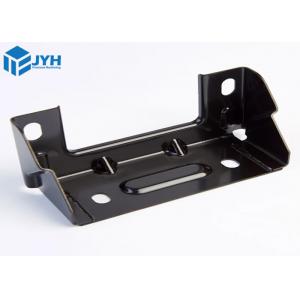Sheet Metal Prototype Fabrication Custom Precision Metal
Fabrication OEM ODM
Sheet Metal Steel Stamping Fabrication Service
Sheet metal fabrication is the most cost-effective choice for
custom sheet metal parts and prototypes with uniform wall
thickness.
We are specialized in transforming raw metal sheets into
high-quality, custom-designed products through cutting-edge
technology, expert craftsmanship, and a commitment to excellence.
Your vision, our metal mastery.
Mid-to-High Volume Sheet Metal Production
For All Your Production Needs
We can produce parts in quantities of 100-10,000. Our in–house
equipment can run lights out, enabling us to provide economical
production solutions.
Quality Commitment
- ISO 9001:2015
- ITAR Registered
- APQP
- PPAP
- Fast delivary service
- Free quotation with DFM review in 1-2 hours
- Deburr all sharp edges: 0.2 - 0.3 mm
Sheet Metal Fabrication Standards
| Dimension Detail | Metric Units | Imperial Units
|
Edge to edge, single surface |
+/- 0.127 mm |
+/- 0.005 in. |
Edge to hole, single surface |
+/- 0.127 mm |
+/- 0.005 in. |
Hole to hole, single surface |
+/- 0.127 mm |
+/- 0.005 in.
|
Bend to edge / hole, single surface |
+/- 0.254 mm |
+/- 0.010 in. |
Edge to feature, multiple surface |
+/- 0.762 mm |
+/- 0.030 in. |
Why use JYH’s for sheet metal fabrication?
Fast quoting & Free DFM feedback
| High Quality & reliability |
Build and edit your quote within 20 minutes. Review your parts for
manufacturability and assess the cost of different materials,
processes and lead times for your project in real time.
| Dedicated JYH’s team to ensure your parts consistently meet your
quality expectations. We also offer phone, email and chat support
for any concerns or questions you may have. |
Available Sheet Metal Fabrication Processes
| Processes | Description | Thickness | Area |
Laser Cutting | Laser cutting is a thermal cutting process that uses high-power
laser to cut metals. |
Up to 40 mm
|
Up to 5000 x 5000 mm |
Plasma Cutting | CNC plasma cutting proves effective for slicing through thicker
sheet metals. |
Up to 40 mm
|
Up to 5000 x 7000 mm |
Bending | It is utilized to sculpt customized prototypes of sheet metal
subsequent to the cutting procedure. |
Up to 10 mm |
Up to 5000 mm |
What is sheet metal fabrication?
Sheet metal fabrication is a manufacturing method that involves
cutting and bending sheets of metal to form different shapes.
Sheet metal fabrication is more cost-effective than CNC machining
when it comes to metal components with uniform wall thickness.
Quality assurance
Our unwavering commitment to product quality assurance in sheet
metal fabrication is evident in every aspect of our process.
Our ISO 9001:2015, ISO 13485, and AS9100D certifications reinforce
our commitment to maintaining the highest standards.
Available surface finishes for sheet metal
Surface finishes are applied after machining and can change the
appearance, surface roughness, hardness and chemical resistance of
the produced parts.
Picture of surface finish
|
Name
|
Description
|
|
Standard | This is our standard finish. Parts as delivered as cut and bent, no
additional treatment applied. Sharp edges are broken and deburred
for safe handling. |
| Bead Blasted | Parts are bead blasted with glass beads which results in a grainy
texture. Sharp edges are broken and deburred for safe handling. |
| Brushed | Parts are manually brushed with grit #180 after cutting and
bending. Sharp edges are broken and deburred for safe handling.
Ideal to reduce the surface roughness of a part. |
| Brused + Anodized type II | Parts are dipped in an anodizing bath (type II) after manual
brushing. Ideal for increasing the corrosion resistance of the
part. Ideal for increasing the corrosion resistance of the part. |
| Powder coated | Powder coating layer is applied directly after fabrication. Sharp
edges are broken and deburred for safe handling. |
| Black oxide | Parts are dipped in a black oxide bath after fabrication. Ideal to
improve improve corrosion resistance and minimize light reflection
in steel components. |
We primarily produce sheet metal components from aluminum,
stainless steel and steel alloys. We have also worked with brass
and bronze. We can procure other types of sheet metal on request.
Stainless Steel – There are several stainless steel types that you can choose
from. They can be austenitic stainless steel. These are
non-magnetic metals with high nickel and chromium levels. They are
widely used due to their resistance to corrosion and formability.
Ferritic stainless, on the other hand, is magnetic. They are good
for non-structural or decorative applications. Martensitic
stainless also gives strong and corrosion-resistant products.
Hot Rolled Steel – A type of steel produced when a series of roll processes (at
over 1700 degrees Fahrenheit) create steel. You can easily form
such steels into large pieces due to their flexibility.
Cold Rolled Steel – This is essentially hot-rolled steel with further processing.
They are smoother and come with better tolerances.
Pre-Plated Steel – These are also referred to as galvanized sheet
metal materials. They come with a protective coating to prevent
them from rusting. They also support easy sheet metal processing
methods due to increased ductility.
Aluminum – Another popular choice for the manufacturing sectors. It comes
with an excellent strength-to-weight ratio. It also comes with many
characteristics that help it meet many application requirements.
Copper/Brass – Working on brass is easy, thanks to its lower zinc content.
Copper metals also come with protective oxide layers to prevent
corrosion. Both materials are desirable in architectural products
for aesthetically pleasing looks.
Payment method
Shipping way
Package method
Frequently Asked Questions
1. What are the tolerances for fabricated parts?
Sheet metal fabrication tolerances refer to the acceptable
deviations for features of sheet metal parts required for accurate
and consistent installation and integration.For sheet metal parts,
ISO 2768-mk is usually used to ensure proper control of the
elements of geometry and size.
The following will show you 7 tolerance standards range of linear
and angular dimensions, flatness & straightness, cylindricity, and
circularity.
2. How much does sheet metal fabrication cost?
Every aspect of a sheet metal fabrication project comes with an
associated cost — the design, possible prototype, finishing
processes, and others. Asides from the process itself, materials
also cost money.
3. What’s K factor in sheet metal?
K factor is the sheet metal process is the ratio of neutral axis to
material thickness. This value changes with respect to the various
physical properties and thickness of materials used.
JYH is your best partner of Steel Stamping Factory Customized
Precision Sheet Metal Fabrication Partner!



